The municipality of Tejeda lies 44 kilometres from the capital of the island, Las Palmas de Gran Canaria. From Las Palmas you can get to Tejeda by taking the GC 15 (Carretera del Centro). It is a rather winding road amid beautiful scenery, passing through the municipalities of Santa Brígida and San Mateo. In a private car the 44-kilometre-drive can be done in about an hour.
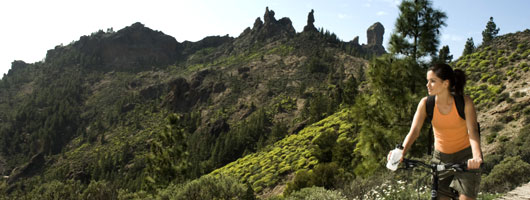
In the case of public transport, the visitor should go to the Bus Station (Estación de Guaguas) in Las Palmas and either take a number 303 bus to San Mateo from where the buses go out number 305 bus towards Tejeda and the number 18 bus that the distance covers Tejeda - San Bartolomé de Tirajana - Faro de Maspalomas.
Culture and art are present in Tejeda as additional options to tourism and leisure activities. Visitors may visit theAbraham Cárdenes Sculpture Museum where they can admire part of the important Canarian sculptor’s work. Abraham Cárdenes was born in Tejeda and was always a great admirer of his homeland. There is also an Ethnographic Museum, which allows the visitor to take a tour through the history of the municipality and of Gran Canaria. There will also be a Medicinal Plants Centre, where the visitor can discover the variety of plants, herbs and flowers which are autochthonous to Tejeda and the island. Besides you will be able to see the different uses these have in medicine, cosmetics and religion.

Tejeda is a must for those who wish to discover the rich archaeological wealth of the island. Archaeological remains such as burial caves, rock carvings, paintings and houses are found in this area. Roque Bentayga offers an excellent example. It is an outstanding natural element which was a sacred place for the native people. It was here that they gave offerings and prayed to their gods. The Cuevas del Rey are located inside the Roque Bentayga, where the visitor can see caves that were used as rooms and granaries, rock carvings, cave paintings and numerous perforations carried out in the rock demonstrating the existence of a pre Hispanic religious centre.
The Centro de Interpretación Degollada de Becerra located on the road between La Cruz de Tejeda and Los Llanos de la Pez is another interesting place to visit. This viewpoint, which offers walkers spectacular views of the surrounding landscape is, above all, an information centre about the local ethnography.
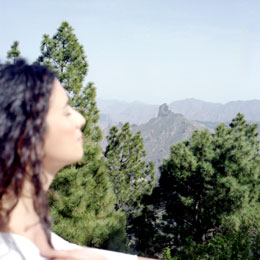

The Bentayga Archaeological Park is an eco-museum situated beside Roque Bentayga offering information about the archaeological complex which includes Roque Bentayga, Andén de Tabacalete, Cuevas del Rey, the Roquete and the surrounding areas. There are extraordinary views from here towards the south and west of the island.
Visitors to Tejeda should not miss the Parochial Church of Nuestra Señora de Socorro, which dates back to 1921. This rectangular building has three naves and large windows allowing natural lighting of a beautiful altarpiece, the most outstanding element in the church.
One of the recommended visits is to the Cruz de Tejeda, from where you can contemplate the most peaceful views of the island. The large stone cross dominates the entrance to the Parador Nacional (state-run hotel). Close by are stalls selling typical products from the area, which are a delight for the visitors.
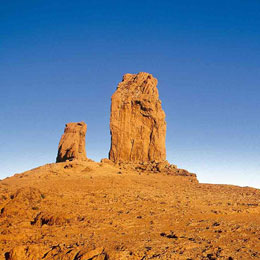

The symbol of Gran Canaria, el Roque Nublo, stands here in Tejeda. This is an enormous basalt monolith of over seventy metres in height, which was formed by volcanic action during the Pleistocene Era. Beside it, to the north-west, is another monolith called El Fraile (the monk), as it looks like a praying monk. If what you really want to see is the natural beauty of the municipality, take an excursion to the Inagua and Ojeda pine forests and, a bit further north, to Los Pechos. The views are magnificent from here as they are from almost anywhere in the municipality, which is the geographical centre of the island.
In the centre of the town there is a shop which sells handicraft and you can buy presents and handicrafts made by local craftsmen there.
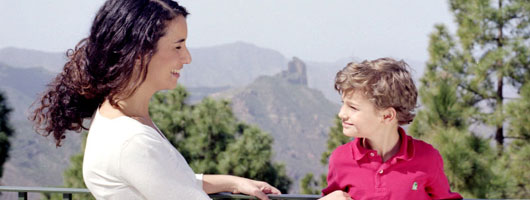
The area around the Cruz de Tejeda, beside the Parador Nacional, is the place where most of the artisans come to sell their traditional products to excursionists and visitors to Tejeda.
Every day, from early in the morning, there is a small street market where visitors can buy typical sweets made in the municipality, as well as a variety of traditional handicrafts. The traditional handicrafts are made of brass and stone. There are wicker baskets and mats, clay pots, leather goods and the typical Canarian openwork. Visitors can stop at the terraces or restaurants which are built along one side of the Parador.
The local crafts offer, principally, traditional elements of brass, stone, baskets and mats realized in wicker, this way as jars of mud, textiles of leather or the typical canary frets.
Almonds are a very important ingredient in the gastronomy of Tejeda, which is one of the leading municipalities for Canary Islands confectionery.
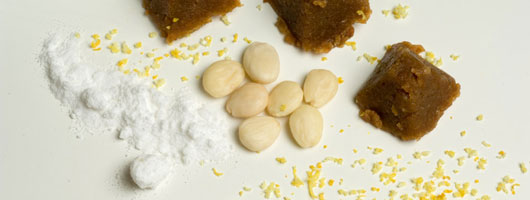
Bienmesabe and marzipans are good examples. Both sweets are made with crushed almonds. Bienmesabe has become a traditional dish served for example with ice-cream.
Any traditional Canarian dish can be tasted in Tejeda. Goat’s meat and beef dishes have an exquisite flavour and the potato soups, watercress and jaramagos (cruciferous plant) stew are excellent.
Tejeda: Download Tourist Brochure | Map | Podcast
Accommodation:Tejeda
Day trips to Tejeda
Tripgrancanaria organizes routes all around the municipalities in the interior of the island, including Tejeda and Roque Nublo.
OKGranCanaria will take you on an itinerary qwhich starts off at the coast of Arucas up to the island’s summit.
Pentraprisma organizes photo-tours so you can learn photographing techniques while you discover many of the island’s less familiar locations.
Discover the peaks of the island with day trips to the interior of Gran Canaria with LCT Gran Canaria.